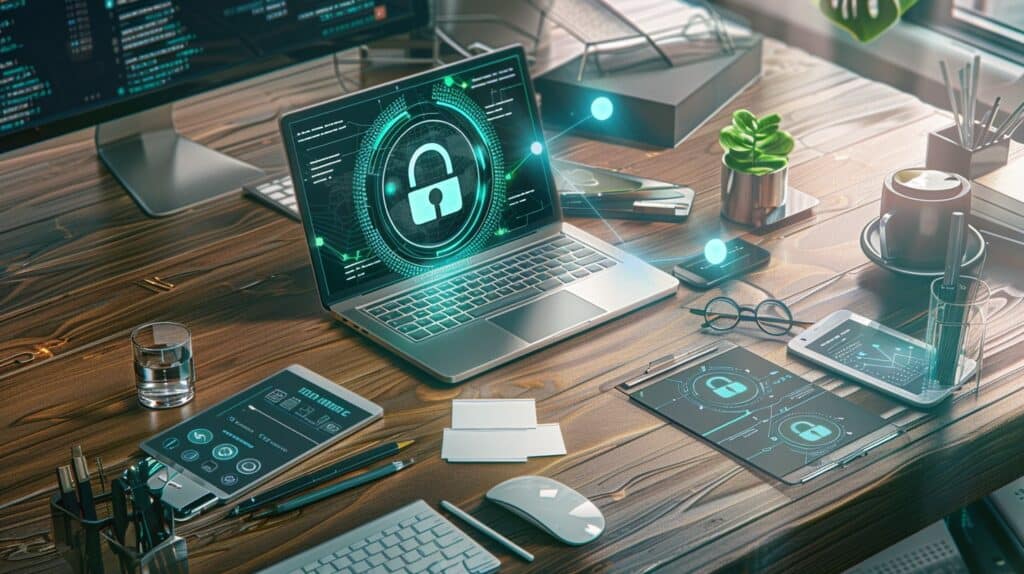Keeping your digital life secure seems harder every day. VPN services like Surfshark shield your online activities. This article shows you 10 simple ways to safeguard your information.
Stay protected—read on.
Key Takeaways
Use password managers like LastPass to keep your passwords safe and secure. This helps stop hackers from getting your private info.
Turn on two-factor authentication for an extra layer of security. It makes it harder for bad guys to access your accounts by adding a second check.
Install anti-malware software such as Malwarebytes to protect against viruses and online threats. Keeping these programs updated is key.
Always make sure websites are secure before entering personal or financial information. Look for “https” and the padlock icon in the web address.
Keep devices safe with strong PINs or biometric locks, and don’t forget to back up important files regularly using cloud services or external drives.
Table of Contents
Essential Tools for Digital Security

For digital safety, you need the right gear. Things like password safes and extra steps for login keep your stuff safe online.
Utilize a Password Manager
Using a Password Manager is a smart move. Apps like LastPass, 1Password, Dashlane, and Keeper make your digital life safer. They store passwords and sensitive info securely. You only need one strong master password to access them all.
This means fewer chances for cybercriminals to get your private data.
These tools also help create tough passwords that are hard to crack. By keeping all your login details in one place, you’re less likely to use weak passwords or repeat them across sites, which improves your online security significantly.
Next up: Activate Two-Factor Authentication to add an extra layer of protection.
Activate Two-Factor Authentication
Activate two-factor authentication (2FA) to add a strong layer to your digital security. Think of it as a double lock for your online accounts, where you need both your password and a unique code from another device, like through Authy or SMS.
This step makes it much harder for cyber criminals to access your private information.
For example, when you log into an email service or social media account, 2FA requires you to enter both your password and the code sent to your phone. It’s like having a secret key that changes every time you use it.
Many services now offer this feature – from banks to gaming platforms – ensuring an extra shield against identity theft and unauthorized access.
Two-factor authentication is not just an option; it’s a necessity for protecting what matters in the digital world.
Combat Cyber Threats Effectively

In today’s digital age, fighting online dangers is key. Learn to spot and avoid phishing scams and keep your devices safe with trusted antivirus tools.
Identify and Dodge Phishing Attacks
Phishing attacks trick you into giving out personal info by pretending to be from trusted sources. Scammers often use emails or messages that look real, with logos from big companies.
They aim to steal your data like passwords and bank details. Always check the sender’s email address carefully; it might look official but have small mistakes.
Never click on links or download attachments from unknown emails. These can contain malware that harms your computer or steals information. Keep an eye out for urgent language in emails asking for immediate action, such as updating payment info or confirming account details.
This is a common trick in phishing scams. Use anti-malware tools like Malwarebytes and antivirus software like Symantec to protect yourself further—update these programs regularly to fight new threats.
Install Trusted Anti-Malware Software
Install anti-malware tools like Malwarebytes, Symantec, and Kaspersky to fight viruses and keep your digital life safe. These programs scan your devices and remove harmful software before it can do damage.
They are essential for guarding against cyber threats that aim to steal sensitive information or control your device.
Make sure your computer, phone, and tablet have antivirus protection. Updates are crucial; they equip your software with the latest defenses against new threats. Running regular scans detects hidden malware you might not know about.
Secure devices mean secure personal data, from bank details to emails on Gmail or photos on Google Drive.
Protect Your Personal and Financial Data

Keep your money and personal info safe online. Use a VPN and browse securely—always check for “https” in web addresses before you share details or buy stuff.
Use a Virtual Private Network (VPN)
A Virtual Private Network, or VPN, shields your online life. ISPs watch everything you do online. But a VPN puts a stop to this by hiding your actions. It sends your internet use through its own server.
This makes sure no one can see what sites you visit or what data you download.
Using a VPN like Surfshark is easy and works for everyone – not just tech experts. With Surfshark, my internet service provider can’t see my activity. This means more privacy and security when browsing the web or using apps on mobile devices and computers.
Plus, it hides my IP address and encrypts my connection, which keeps hackers away when I’m on public Wi-Fi. Read more about Surfshark to understand how it provides protection while allowing me to enjoy secure access to any content from anywhere in the world.
Adopt Secure Browsing Techniques
Safe web browsing starts with using the right tools and knowing what to look for. Always check if a website has a small padlock before its URL. This means it’s secure. Also, make sure the site uses HTTPS, not just HTTP.
HTTPS encrypts your connection, keeping your data safe.
Use search engines like DuckDuckGo that don’t track you. This protects your searches from prying eyes. For extra security, switch to browsers focused on privacy, like Tor Browser. It helps hide your online activities even more.
These steps keep your digital life private and secure from hackers and trackers looking to steal personal information.
Ensure Transactions are on Secure Websites
After adopting secure browsing techniques, it’s crucial to focus on where you enter your financial details. Make sure every time you shop or do any transaction online, the website starts with “HTTPS” not just “HTTP.” This extra “S” stands for secure.
It means all data between your browser and the site is encrypted—hidden from hackers.
Look for a padlock icon next to the website address, too. This symbol guarantees that your connection to the site is private and protected. Before typing in your credit card or bank info, double-check these security signs are there.
Also, only share personal details with sites you trust. If something feels off about a website, trust your gut and don’t put in any sensitive information.
Your digital safety hinges on securing each online transaction.
Enhance Device Security

To keep your gadgets safe, lock them with codes or touch ID. Always install new updates to fight off hackers and bugs.
Secure Devices with PINs or Biometric Locks
Secure your phones and tablets with PINs or biometric locks. This simple step keeps strangers out of your personal data. Think fingerprints or facial recognition for speedy access that’s also secure.
It’s like having a unique key to your digital life.
Always choose a strong PIN, not just easy numbers like 1234. For even better security, switch on biometric authentication, where available. Your device stays locked to everyone but you.
Next up, ensure all devices get regular updates and patches.
Update and Patch Devices Regularly
Regular updates fix glitches and privacy issues. They keep your devices safe.
- Turn on automatic updates for your operating systems, such as Windows 10 or iOS (Apple). This ensures you get the latest security fixes without delay.
- Check app stores like Apple App Store and Google Play for updates to your apps. Developers often release patches to close security holes.
- Use antivirus programs on your computers and phones. Programs like NordVPN and KeePass also need regular updating to protect against cyber threats effectively.
- Create backups of important files using services like iCloud, Dropbox, or OneDrive. In case malware damages your device, you won’t lose everything.
- Connect to secure internet connections before downloading any updates. Public Wi-Fi can be dangerous.
- Pay attention to email alerts from software providers about critical updates or patches.
- Review the privacy settings on social media platforms such as Facebook, Twitter, and Instagram after each update, as changes might affect what information is public.
- Encrypt sensitive files in the cloud using services like Google Photos or Backblaze to prevent unauthorized access during data transfers.
- Install a reliable VPN (Virtual Private Network) to secure your internet connection while updating devices over unsecured networks.
- Regularly change passwords for all online accounts and use a password manager to keep track of them.
These actions will help keep your digital life secure against evolving cybersecurity threats.
Maintain Data Integrity and Backup

Keep your files safe—always have a backup. Use cloud services or external hard drives to save copies of your important stuff.
Backup Important Files Regularly
Losing data can disrupt your life. Regular backups are the shield against this chaos.
- Set a schedule to back up files weekly. This routine ensures you don’t lose important updates.
- Use online storage services like Google Drive, iCloud, or Dropbox for easy access anywhere. These platforms store your photos, documents, and more securely in the cloud.
- Keep an external hard drive or USB drive handy for a physical copy of your data. It’s a good plan to have a tangible backup in case of internet issues.
- Automate the backup process with software that can handle it for you. Tools like Windows Store apps or macOS’s Time Machine can save time and effort.
- Verify backups by checking files periodically to make sure they’re complete and usable.
- Encrypt sensitive files before uploading them to cloud services or external drives for extra security against unauthorized access.
- Invest in a reliable antivirus and anti-malware program to protect backups from being corrupted by malicious software.
- Follow the 3-2-1 rule: 3 copies of any important file, on 2 different media, with 1 stored offsite—like online storage—to avoid total loss from disasters at one location.
- Share backup responsibilities if possible; ask family members to remind each other about regular data backup routines.
- Update backed-up files after major changes or additions to ensure your backup stays current and useful.
By sticking closely to these steps, you guard your digital life effectively against unexpected data loss events.



This article provides a well-rounded guide to protecting your digital life, incorporating a diverse range of thematic areas, from password management to ensuring secure transactions, which are crucial in today’s cyber landscape. I appreciated the clear emphasis on tools like VPNs and password managers which are often underestimated in their effectiveness.
However, I would have liked to see a deeper dive into the complexities of biometric security measures, which may not always be infallible. While PINs and biometric locks serve as robust options for securing devices, it’s important to highlight their vulnerabilities too; biometrics can be tricked and devices stolen.
Moreover, while the use of a VPN is rightly advocated, the nuances of VPN jurisdiction and potential logging policies could further educate readers on making informed choices about which VPN providers truly enhance their privacy.
Nonetheless, the step-by-step format is highly practical for anyone looking to immediately bolster their online security, coupling easy-to-follow advice with action steps that offer real protection. The use of visual aids and embedded videos also enhances understanding, making complex topics accessible, which is fundamental when addressing a broad audience.
All in all, this blogpost serves as a robust guide, but could benefit from addressing the complexities of recommended security measures to provide a more holistic view.
The advice on using password managers and two-factor authentication is solid, but suggesting Surfshark VPN and other specific products as blanket solutions raises eyebrows. It’s imperative to highlight that not all VPNs provide the same level of security, and many may actually compromise user data under the guise of protection. It’s crucial for users to conduct thorough research rather than blindly trusting recommendations which might be sponsored or biased. Also, the emphasis on anti-malware software could use a dose of reality—it’s not just about installing it, but understanding it doesn’t make one invincible online. Cybersecurity is complex and requires a more nuanced approach than just a checklist of tools to install.
This article is a valuable guide that enfolds the essence of protecting our digital presence in a comprehensive manner. Embracing these secure and simple digital practices is akin to nurturing and safeguarding the inner peace that comes from knowing our sacred spaces—both physical and virtual—are secure. By incorporating tools like password managers and VPNs, and by being vigilant about where and how we share our personal information, we’re not just defending data but preserving the serenity of our daily interactions and transactions. It reminds us that in the age of digital connectivity, mindfulness is just as crucial online as it is in our offline practices. By ensuring the integrity of our digital engagements, we honor and respect the energy we invest in every facet of our lives. Thank you for this enlightening read, a true beacon for those seeking to harmonize their spiritual and digital realms.
All this talk about digital security is just another way for big corporations and governments to track and control us. Think about it, who benefits from you using all these password managers and VPNs? It’s the same companies telling you that you’re at risk! They scare you into handing over your data willingly. Wake up, people! Real security comes from staying off the grid and using your own methods to stay safe, not relying on tools that could just as well be collecting your data for those who aim to exploit you. And all this two-factor authentication and biometric data collection? It’s just deeper surveillance.
This blog post is a fantastic primer for anyone looking to boost their digital security. As someone who values the health and safety of all aspects of life, I find the emphasis on robust password management and two-factor authentication especially useful. It’s like maintaining a balanced diet for your digital life—essential for keeping everything in check and functioning well. The analogy of a VPN as a privacy shield also resonates with me; it’s similar to having a personal trainer for your online journeys, guiding and protecting you through the virtual landscape. This is a must-read for staying fit and safe in the digital realm. Thanks for sharing such valuable tips!